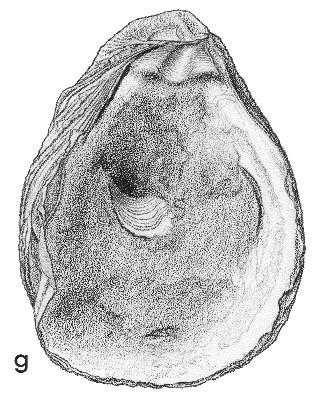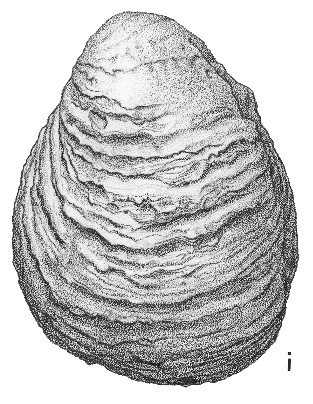
Revised descriptions of New Zealand Cenozoic Mollusca from Beu and Maxwell (1990)

 | Revised descriptions of New Zealand Cenozoic Mollusca from Beu and Maxwell (1990) | 
|
  (Pl. 11g): holotype, "Oamaru" (age uncertain, probably Duntroonian or Waitakian) (TM2854, GNS) |
  (Pl. 11i): holotype, "Oamaru" (age uncertain, probably Duntroonian or Waitakian) (TM2854, GNS) |
Beu & Maxwell (1990): Chapter 10; p. 145; pl. 11 g, i.
Synonymy: Ostrea incurva Hutton 1873b, p.35 (not of Nilsson, 1827); Ostrea wollastoni Finlay 1927b, p. 528 (new name for O. incurva Hutton, preoccupied); O. (Gigantostrea) wollastoni
Classification: Ostreidae: Ostreinae
Description: Large for family (height 140-160 mm), thick-shelled, ovate, subequilateral. No vesicular shell-layers. Left valve more inflated than right but shell-cavity not deep and not extending under umbo. Ventral margin broadly and deeply folded, some shells with shallow sulcus on left valve running from umbo to posterior end of fold. Attachment area rather small. Sculpture on left valve of imbricated growth ridges, some shells with irregular radial corrugations as well; right valve with more regular and more numerous growth ridges. Ligamental area moderately large with a very broad resilifer. Chomata absent. Adductor muscle scar large, reniform, dorsal margin concave, strongly inclined to interior of shell on left valve, less so on right valve, situated posterior to middle of shell.
Comparison: This species has long been included in Gigantostrea (= Pycnodonte), but the reniform (rather than circular or subcircular) adductor muscle scar and the absence of vesicular shell material indicate assignment to the Ostreidae. It is particularly similar to Ostrea hemiglobosa Romanovskiy, 1884 (Eocene; USSR and Afghanistan), the type species of Solidostrea Vyalov, 1948, which has been somewhat doubtfully synonymised with Flemingostrea Vredenburg, 1916 by Stenzel (in Moore 1971, p. N1150, 1153).
Ostrea suteri Ihering (1907, p. 94) may be an earlier name for this oyster. The type material of O. suteri is allegedly from "Westport", but the sole specimen we are aware of in New Zealand collections that has been identified as O. suteri (in GNS, from H. Suter's collection, labelled "O. suteri Ihering" in Suter's handwriting) bears the locality "Kahurangi, southwest Nelson" (Duntroonian or Waitakian). As we are not aware of any possible locality for such an oyster near Westport, the type locality seems likely to be Kahurangi Point. The specimen in Suter's collection is articulated and partly enclosed in matrix, and is much thinner-shelled than most specimens of F. wollastoni, and we cannot be sure it is conspecific with F. wollastoni. The question can be resolved only by comparison of good material from the two type localities.
Distribution: Duntroonian-Waitakian; "Oamaru" (type—probably from Kokoamu Greensand or Gee Greensand, North Otago); Otekaike Limestone, Campbell Park School, Otekaike Valley; Trig Z, Otiake; Chatton Formation, Shell Gully, Chatton; Waikaia, Southland. Many of the records of "giant" oysters from the Landon Series are probably of this or a related species, but most specimens are articulated or poorly preserved or both and are not confidently assignable to genera.
Cite this publication as: "A.G. Beu and J.I. Raine (2009). Revised
descriptions of New Zealand Cenozoic Mollusca from Beu and Maxwell (1990). GNS
Science miscellaneous series no. 27."
© GNS Science, 2009
ISBN
978-0-478-19705-1
ISSN 1177-2441
(Included with a PDF facsimile file
copy of New Zealand Geological Survey Paleontological Bulletin 58 in CD version
from: Publications Officer, GNS Science, P.O. Box 30368 Lower Hutt, New
Zealand)